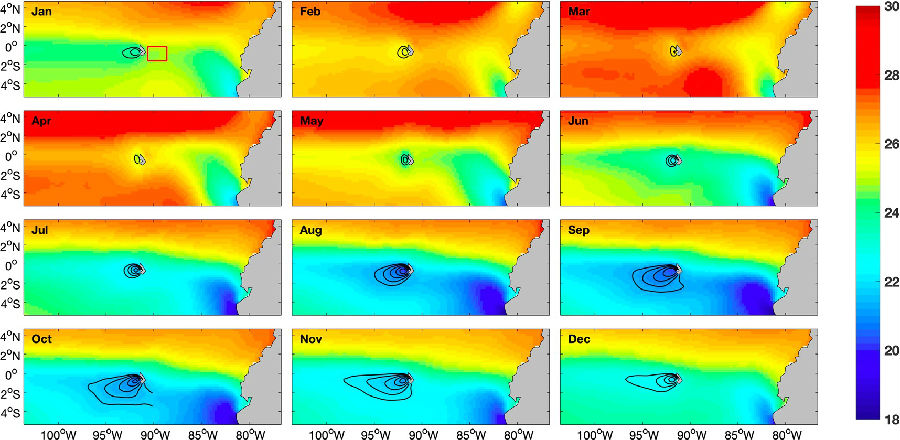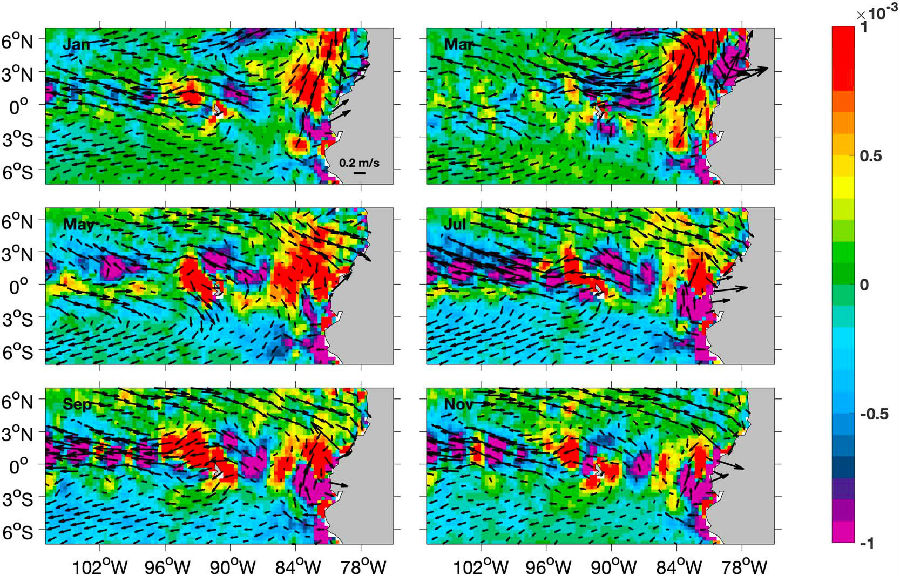On May 7th, Chen Yue, a PhD student in the Department of Earth System Sciences, published a paper inJournal of Geophysical Research – Oceans, entitled”Seasonal and Interannual Variations of Sea Temperature Influenced by Galápagos Islands in Eastern Tropical Pacific Ocean“. The corresponding author is Prof. Huang Xiaomeng in the Department of Earth System Sciences. This is a joint research paper collaborated with Dr. Lu Youyu from Bedford Institute of Oceanography in Canada, Dr. Zhao Peng from Beihai Forecast Center, and Professor Xu Fanghua from the Department of Earth System Science. The paper proposes a new index to quantitatively characterize the effects of the Galápagos archipelago on the seasonal and interannual scales of the equatorial eastern Pacific currents, and further reveals and complements the influence mechanism of the Galápagos Islands on sea-air interactions.

The Optimal Interpolation version 2 gridded sea surface temperature (SST; color shading, in °C) averaged over 1993–2016 for each month. The contours mark regions of cold core.
The eastern tropical Pacific is an important area of the coupled atmosphere-ocean system. The presence of the Galápagos Islands (GI), located between 89 oW and 92 oW, provides a topographic barrier for circulation and equatorial waves and influences the variations of ocean temperature and salinity, as well as unique ecosystem and ecology of the region. In this study, the sea surface temperature and surface currents based on satellite remote sensing, along with the ocean temperature and currents from a data assimilative ocean simulation product, are analyzed to investigate the influence of the GI in the eastern tropical Pacific on the sea surface temperature. On seasonal timescales, the temperature index and area index proposed in this paper show that the GI's impact is stronger (weaker) in boreal fall (spring). At interannual timescales, the correlations of the temperature and area indices with the Ni?o3 index suggest consistent relationship between the GI's impact with the ENSO cycle: stronger in La Ni?a years and weaker in El Ni?o years. While the present study focuses on quantifying and understanding the GI's influence on the SST, the results are potentially valuable in understanding the GI's role in the coupled atmosphere‐ocean system. From the physical mechanisms, the three indexes are related to that of the spatial distributions of the upper ocean temperature, the advection of temperature by the horizontal currents, specifically the north branch of the South Equatorial Current, and upwelling in the eastern tropical Pacific. The results are potentially valuable in understanding the GI's role in the coupled atmosphere‐ocean system.

The Ocean Surface Current Analysis Real‐Time surface current (vectors) and the rate of sea surface temperature increase (color shading, in °C/s) averaged for January, March, May, July, September, and November during 1993–2016.
Chen Yue is a fourth year Ph.D. student in Department of Earth System Sciences. Her research interests are atmosphere-ocean interactions, the use of ENSO and machine learning in climatology and weather forecasting.
Fulltext link:
https://doi.org/10.1029/2018JC014523